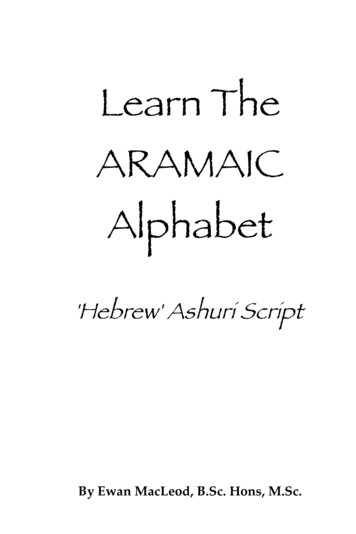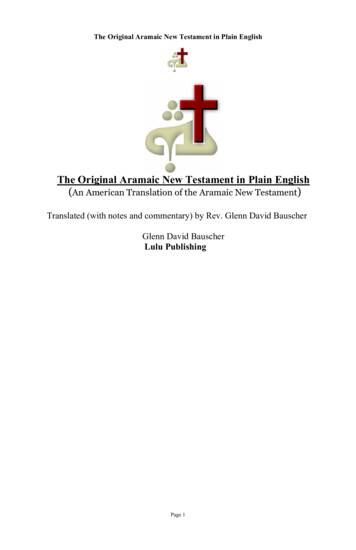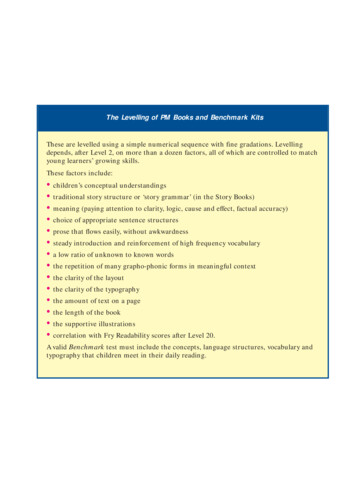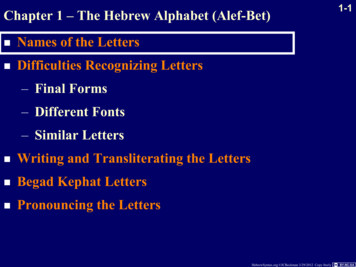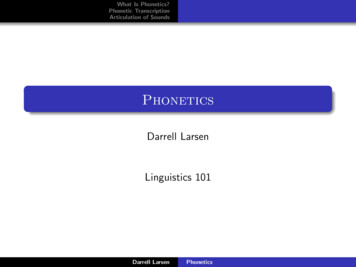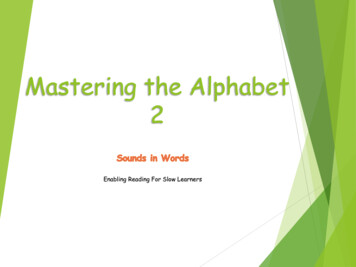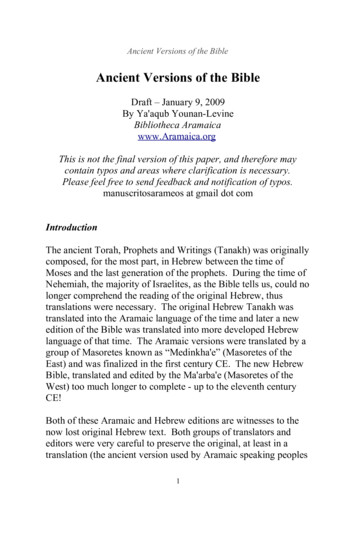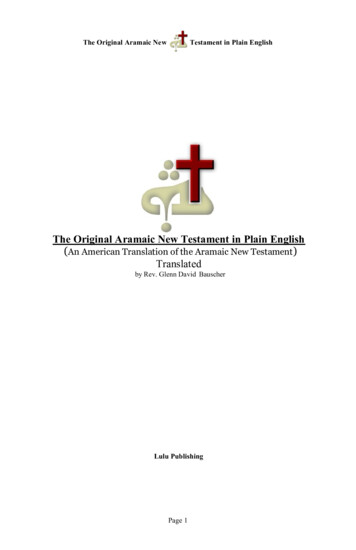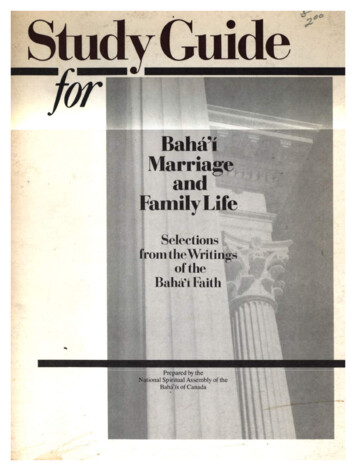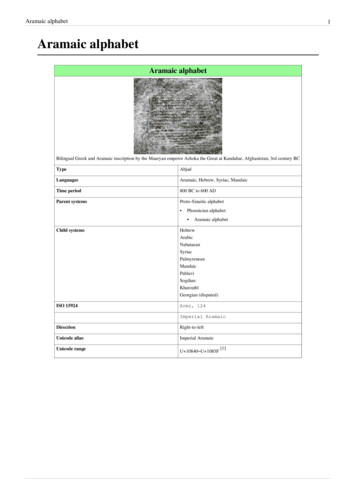
Transcription
Aramaic alphabet1Aramaic alphabetAramaic alphabetBilingual Greek and Aramaic inscription by the Mauryan emperor Ashoka the Great at Kandahar, Afghanistan, 3rd century BCTypeAbjadLanguagesAramaic, Hebrew, Syriac, MandaicTime period800 BC to 600 ADParent systemsProto-Sinaitic alphabet Phoenician alphabet Aramaic alphabetChild icPahlaviSogdianKharoṣṭhīGeorgian (disputed)ISO 15924Armi, 124Imperial AramaicDirectionRight-to-leftUnicode aliasImperial AramaicUnicode rangeU 10840–U 1085F[1]
Aramaic alphabet2Aramaeans AramaiclanguageAramaicalphabetAramaean kingdoms Aram-DamascusPaddan AramAram RehobAram SobaAramaean kings Reson Hezjon Tabrimmon Ben-Hadad Ben-Hadad II Ben-Hadad III Hazael Hadadezer RezinThe Aramaic alphabet is adapted from the Phoenician alphabet and became distinctive from it by the 8th centuryBCE. The letters all represent consonants, some of which are matres lectionis, which also indicate long vowels.The Aramaic alphabet is historically significant, since virtually all modern Middle Eastern writing systems can betraced back to it, as well as numerous non-Chinese writing systems of Central and East Asia. This is primarily due tothe widespread usage of the Aramaic language as both a lingua franca and the official language of the Neo-AssyrianEmpire, and its successor, the Achaemenid Empire. Among the scripts in modern use, the Hebrew alphabet bears theclosest relation to the Imperial Aramaic script of the 5th century BC, with an identical letter inventory and, for themost part, nearly identical letter shapes.Writing systems that indicate consonants but do not indicate most vowels (like the Aramaic one) or indicate themwith added diacritical signs, have been called abjads by Peter T. Daniels to distinguish them from later alphabets,such as Greek, that represent vowels more systematically. This is to avoid the notion that a writing system thatrepresents sounds must be either a syllabary or an alphabet, which implies that a system like Aramaic must be eithera syllabary (as argued by Gelb) or an incomplete or deficient alphabet (as most other writers have said); rather, it is adifferent type.HistoryOriginsThe earliest inscriptions in the Aramaic language use the Phoenician alphabet. Over time, the alphabet developedinto the form shown below. Aramaic gradually became the lingua franca throughout the Middle East, with the scriptat first complementing and then displacing Assyrian cuneiform as the predominant writing system.Achaemenid periodAround 500 BC, following the Achaemenid conquest of Mesopotamia under Darius I, Old Aramaic was adopted bythe conquerors as the "vehicle for written communication between the different regions of the vast empire with itsdifferent peoples and languages. The use of a single official language, which modern scholarship has dubbed Official
Aramaic alphabetAramaic or Imperial Aramaic, can be assumed to have greatly contributed to the astonishing success of theAchaemenids in holding their far-flung empire together for as long as they did."[2]Imperial Aramaic was highly standardised; its orthography was based more on historical roots than any spokendialect and was inevitably influenced by Old Persian.For centuries after the fall of the Achaemenid Empire in 331 BC, Imperial Aramaic—or near enough for it to berecognisable—would remain an influence on the various native Iranian languages. The Aramaic script would surviveas the essential characteristics of the Pahlavi writing system.A group of thirty Aramaic documents from Bactria have been recently discovered. An analysis was published inNovember 2006. The texts, which were rendered on leather, reflect the use of Aramaic in the 4th century BCAchaemenid administration of Bactria and Sogdiana.Its widespread usage led to the gradual adoption of the Aramaic alphabet for writing the Hebrew language. Formerly,Hebrew had been written using an alphabet closer in form to that of Phoenician (the Paleo-Hebrew alphabet).Aramaic-derived scriptsSince the evolution of the Aramaic alphabet out of the Phoenician one was a gradual process, the division of theworld's alphabets into those derived from the Phoenician one directly and those derived from Phoenician viaAramaic is somewhat artificial. In general, the alphabets of the Mediterranean region (Anatolia, Greece, Italy) areclassified as Phoenician-derived, adapted from around the 8th century BCE, while those of the East (the Levant,Persia, Central Asia and India) are considered Aramaic-derived, adapted from around the 6th century BCE from theImperial Aramaic script of the Achaemenid Empire.After the fall of the Achaemenid Empire, the unity of the Imperial Aramaic script was lost, diversifying into anumber of descendant cursives.The Hebrew and Nabataean alphabets, as they stood by the Roman era, were little changed in style from the ImperialAramaic alphabet.A Cursive Hebrew variant developed from the early centuries AD, but it remained restricted to the status of a variantused alongside the non-cursive. By contrast, the cursive developed out of the Nabataean alphabet in the same periodsoon became the standard for writing Arabic, evolving into the Arabic alphabet as it stood by the time of the earlyspread of Islam.The development of cursive versions of Aramaic also led to the creation of the Syriac, Palmyrenean and Mandaicalphabets. These scripts formed the basis of the historical scripts of Central Asia, such as the Sogdian and Mongolianalphabets.It has been suggested that the Old Turkic script in 8th century epigraphy originated in the Aramaic script.ModernToday, Biblical Aramaic, Jewish Neo-Aramaic dialects and the Aramaic language of the Talmud are written in theHebrew alphabet. Syriac and Christian Neo-Aramaic dialects are written in the Syriac alphabet. Mandaic is writtenin the Mandaic alphabet.Due to the near-identity of the Aramaic and the classical Hebrew alphabets, Aramaic text is mostly typeset instandard Hebrew script in scholarly literature.3
Aramaic alphabet4Imperial Aramaic alphabetRedrawn from A Grammar of Biblical Aramaic, Franz Rosenthal; forms are as used in Egypt, 5th century BC.Names are as in Biblical Aramaic.Letter nameLetter formLetterEquivalent Letter in .Sound valueHebrew Arabic Syriac Brahmi Nabataean ṬēthYudhKāphLāmadhMimႄ ܐ ﺍ א ႄ ܒ ﺑـ ב ႄ ܓ ﺟ ג ႄ ﺩ ד , ܕﺫ ႄ ܗ ﻫ ה ႄ ܘ ﻭ ו ႄ ܙ ﺯ ז ႄ ﺧ ח , ܚﺣ ႄ ܛﻁ ט ႄ ܝ ﻳـ י ႄ ܟܟ ﻙ כ ?/ʔ/; /aː/, /eː//b/, /v//ɡ/, /ɣ//d/, /ð/?/h//w/; /oː/, /uː/?/z/?/ħ/ ך ႄ ܠ ﻟـ ל ႄ ܡܡ ﻣ מ ם emphatic /tˤ//j/; /iː/, /eː//k/, /x//l//m/
Aramaic auႄ נ ן ႄ ס ႄ ע ႅ פ ף ႅ צ ץ ႅ ק ႅ ר ႅ ש ႅ ת ܢܢ ﻥ ܢ ܣ ﻏ , ܥﻋ ܦ ﻓـ /n/-?/s/?/ʕ//p/, /f/ ܨ ﺻـ emphatic /sˤ/ ܩ ﻗـ ܪ ﺭ ﺷ , ܫﺳ ﺗـ , ܬﺛـ /q//r//ʃ//t/, /θ/Matres lectionisThe letters Waw and Yudh, put following the consonants that were followed by the vowels u and i (and often also oand e), are used to indicate the long vowels û and î respectively (often also ô and ê respectively). These letters, whichstand for both consonant and vowel sounds, are known as matres lectionis. The letter Alaph, likewise, had some ofthe characteristics of a mater lectionis: in initial positions, it indicated a specific consonant called glottal stop(followed by a vowel), and, in the middle of the word and word finally, it often also stood for the long vowels â or ê.Among Jews, influence of Hebrew spelling often led to the use of He instead of Alaph in word final positions. Thepractice of using certain letters to hold vowel values spread to child writing systems of Aramaic, such as Hebrew andArabic, where they are still used today.
Aramaic alphabet6UnicodeThe Aramaic alphabet was added to the Unicode Standard in October, 2009 with the release of version 5.2.The Unicode block for Imperial Aramaic is U 10840–U 1085F:Imperial Aramaic[1]Unicode chart [1] (PDF)U 1084xU 1085x0 1 2 3 4 5 6 7 8 9 A B C D E Fႄ ႄ ႄ ႄ ႄ ႄ ႄ ႄ ႄ ႄ ႄ ႄ ႄ ႄ ႄ ႄႅ ႅ ႅ ႅ ႅ ႅ ႅ ႅ ႅ ႅ ႅ ႅ ႅ ႅ ႅNotes1. As of Unicode version 6.3References[1] http:/ / www. unicode. org/ charts/ PDF/ U10840. pdf[2] p. 251 Byrne, Ryan. “Middle Aramaic Scripts.” Encyclopaedia of Language and Linguistics. Elsevier. (2006)Daniels, Peter T., et al. eds. The World's Writing Systems. Oxford. (1996)Coulmas, Florian. The Writing Systems of the World. Blackwell Publishers Ltd, Oxford. (1989)Rudder, Joshua. Learn to Write Aramaic: A Step-by-Step Approach to the Historical & Modern Scripts. n.p.:CreateSpace Independent Publishing Platform, 2011. 220 pp. ISBN 978-1461021421 Includes a wide variety ofAramaic scripts. Ancient Hebrew and Aramaic on Coins, reading and transliterating Proto-Hebrew, online edition (http://judaea.chimehost.net/main/text.pdf). (Judaea Coin Archive)External links Comparison of Aramaic to related alphabets (http://www.sakkal.com/Arab Calligraphy Art3.html) Omniglot entry (http://www.omniglot.com/writing/aramaic.htm)
Article Sources and ContributorsArticle Sources and ContributorsAramaic alphabet Source: https://en.wikipedia.org/w/index.php?oldid 580038731 Contributors: 334a, A2raya07, Aeusoes1, AgadaUrbanit, AjitPD, Amire80, Ariobarzan, Aris riyanto,Asfarer, Bailey98, Brando130, Brion VIBBER, Byrnes777, Calcwatch, CharlesMartel, ChrisGualtieri, CiteCop, Conscious, Conversion script, Crimsonmargarine, Cripipper, Crissov,Cronholm144, Dan Pelleg, Dbachmann, DePiep, DerBorg, DopefishJustin, Dougweller, Drmccreedy, Editor2020, Elvis214, Evertype, Fconaway, FilipeS, Florian Blaschke, FokkerTISM,Foreign1, Futhark, Future Perfect at Sunrise, Garzo, Good Olfactory, Grenavitar, Hmains, Hurt, Ikiroid, Imz, Indexheavy, Insanity Incarnate, Izzedine, J R Gainey, Jagged 85, Jaqeli, Jataayu1,Jguk, Jtygs, Judaeosemitist, Koavf, Kpjas, Kwamikagami, La goutte de pluie, Lee Daniel Crocker, Lockesdonkey, MacedonianBoy, Magioladitis, Mahmudmasri, Makecat, Mhss, Mianmarble,Michael Hardy, Mikko Paananen, Minesweeper, Mintguy, Monedula, Mordynu, Mrrhum, Mustafaa, Naevus, Nk, Nnemo, No Guru, Node ue, Nrotta, Numbo3, Omar-Toons, Optikos, Per Honoret Gloria, PhatJew, Pjacobi, PlatypeanArchcow, PuzzletChung, Rich Farmbrough, Rjwilmsi, Rosenzweig, Rtelkin, Sardanaphalus, Sburke, SchuminWeb, Skamecrazy123, Smettems, StAnselm,Swid, TaalVerbeteraar, Taichi, Tchoutoye, The Thadman, Thnidu, Throttleryn, Thumperward, Tomchiukc, TomeHale, TreasuryTag, Vanisaac, Varlaam, Vassili Nikolaev, VegardNorman,Wathiik, Wikinger, Wikitiki89, XLerate, Xnuala, Yurik, Zhen Lin, Zigger, Zzlatz, ﺃﺣﻤﺪ , ﮐﺎﺷﻒ ﻋﻘﯿﻞ , 126 anonymous editsImage Sources, Licenses and ContributorsFile:AsokaKandahar.jpg Source: https://en.wikipedia.org/w/index.php?title File:AsokaKandahar.jpg License: Public Domain Contributors: Abhishekjoshi, Archidamus, Gryffindor, Iustinus,JMCC1, Jastrow, Le Behnam, Mahmudmasri, Man vyi, Mikhail Ryazanov, Mmcannis, Officer, Ranveig, Roland zh, Sreejithk2000 AWB, Storkk, The Evil IP address, Wiki-uk, World Imaging,Zaccarias, 11 anonymous editsFile:Aleph.svg Source: https://en.wikipedia.org/w/index.php?title File:Aleph.svg License: Creative Commons Attribution-ShareAlike 3.0 Unported Contributors: User:Cronholm144File:Brahmi a.svg Source: https://en.wikipedia.org/w/index.php?title File:Brahmi a.svg License: Public Domain Contributors: MhssFile:01 aleph.svg Source: https://en.wikipedia.org/w/index.php?title File:01 aleph.svg License: GNU Free Documentation License Contributors: SelfFile:Kharosthi a.svg Source: https://en.wikipedia.org/w/index.php?title File:Kharosthi a.svg License: Public Domain Contributors: MhssFile:Beth.svg Source: https://en.wikipedia.org/w/index.php?title File:Beth.svg License: Creative Commons Attribution-ShareAlike 3.0 Unported Contributors: User:Cronholm144File:Brahmi b.svg Source: https://en.wikipedia.org/w/index.php?title File:Brahmi b.svg License: Public Domain Contributors: MhssFile:02 bet.svg Source: https://en.wikipedia.org/w/index.php?title File:02 bet.svg License: GNU Free Documentation License Contributors: SelfFile:Kharosthi b.svg Source: https://en.wikipedia.org/w/index.php?title File:Kharosthi b.svg License: Public Domain Contributors: MhssFile:Gimel.svg Source: https://en.wikipedia.org/w/index.php?title File:Gimel.svg License: Creative Commons Attribution-ShareAlike 3.0 Unported Contributors: User:Cronholm144File:Brahmi g.svg Source: https://en.wikipedia.org/w/index.php?title File:Brahmi g.svg License: Public Domain Contributors: MhssFile:03 gimel.svg Source: https://en.wikipedia.org/w/index.php?title File:03 gimel.svg License: GNU Free Documentation License Contributors: SelfFile:Kharosthi g.svg Source: https://en.wikipedia.org/w/index.php?title File:Kharosthi g.svg License: Public Domain Contributors: MhssFile:Daleth.svg Source: https://en.wikipedia.org/w/index.php?title File:Daleth.svg License: Creative Commons Attribution-ShareAlike 3.0 Unported Contributors: User:Cronholm144File:Brahmi dh.svg Source: https://en.wikipedia.org/w/index.php?title File:Brahmi dh.svg License: Public Domain Contributors: MhssFile:04 dal.svg Source: https://en.wikipedia.org/w/index.php?title File:04 dal.svg License: Creative Commons Attribution-ShareAlike 3.0 Unported Contributors: User:Cronholm144File:Kharosthi dh.svg Source: https://en.wikipedia.org/w/index.php?title File:Kharosthi dh.svg License: Public Domain Contributors: MhssFile:He0.svg Source: https://en.wikipedia.org/w/index.php?title File:He0.svg License: Creative Commons Attribution-ShareAlike 3.0 Unported Contributors: User:Cronholm144File:05 ha.svg Source: https://en.wikipedia.org/w/index.php?title File:05 ha.svg License: Creative Commons Attribution-ShareAlike 3.0 Unported Contributors: User:Cronholm144File:Waw.svg Source: https://en.wikipedia.org/w/index.php?title File:Waw.svg License: Creative Commons Attribution-ShareAlike 3.0 Unported Contributors: User:Cronholm144File:Brahmi v.svg Source: https://en.wikipedia.org/w/index.php?title File:Brahmi v.svg License: Public Domain Contributors: MhssFile:06 waw.svg Source: https://en.wikipedia.org/w/index.php?title File:06 waw.svg License: Creative Commons Attribution-ShareAlike 3.0 Unported Contributors: User:Cronholm144File:Kharosthi v.svg Source: https://en.wikipedia.org/w/index.php?title File:Kharosthi v.svg License: Public Domain Contributors: MhssFile:Zayin.svg Source: https://en.wikipedia.org/w/index.php?title File:Zayin.svg License: Creative Commons Attribution-ShareAlike 3.0 Unported Contributors: User:Cronholm144File:07 zayn.svg Source: https://en.wikipedia.org/w/index.php?title File:07 zayn.svg License: Creative Commons Attribution-ShareAlike 3.0 Unported Contributors: User:Cronholm144File:Heht.svg Source: https://en.wikipedia.org/w/index.php?title File:Heht.svg License: Creative Commons Attribution-ShareAlike 3.0 Unported Contributors: User:Cronholm144File:08 ha.svg Source: https://en.wikipedia.org/w/index.php?title File:08 ha.svg License: Creative Commons Attribution-ShareAlike 3.0 Unported Contributors: User:Cronholm144File:Teth.svg Source: https://en.wikipedia.org/w/index.php?title File:Teth.svg License: Creative Commons Attribution-ShareAlike 3.0 Unported Contributors: User:Cronholm144File:Brahmi th.svg Source: https://en.wikipedia.org/w/index.php?title File:Brahmi th.svg License: Public Domain Contributors: MhssFile:09 taa.svg Source: https://en.wikipedia.org/w/index.php?title File:09 taa.svg License: Creative Commons Attribution-ShareAlike 3.0 Unported Contributors: User:Cronholm144File:Kharosthi th.svg Source: https://en.wikipedia.org/w/index.php?title File:Kharosthi th.svg License: Public Domain Contributors: MhssFile:Yod.svg Source: https://en.wikipedia.org/w/index.php?title File:Yod.svg License: Creative Commons Attribution-ShareAlike 3.0 Unported Contributors: User:Cronholm144File:Brahmi y.svg Source: https://en.wikipedia.org/w/index.php?title File:Brahmi y.svg License: Public Domain Contributors: MhssFile:10 yaa.svg Source: https://en.wikipedia.org/w/index.php?title File:10 yaa.svg License: Creative Commons Attribution-ShareAlike 3.0 Unported Contributors: User:Cronholm144File:Kharosthi y.svg Source: https://en.wikipedia.org/w/index.php?title File:Kharosthi y.svg License: Public Domain Contributors: MhssFile:Kaph.svg Source: https://en.wikipedia.org/w/index.php?title File:Kaph.svg License: Creative Commons Attribution-ShareAlike 3.0 Unported Contributors: User:Cronholm144File:Brahmi k.svg Source: https://en.wikipedia.org/w/index.php?title File:Brahmi k.svg License: Public Domain Contributors: MhssFile:11 kaf.svg Source: https://en.wikipedia.org/w/index.php?title File:11 kaf.svg License: Creative Commons Attribution-ShareAlike 3.0 Unported Contributors: User:Cronholm144File:Kharosthi k.svg Source: https://en.wikipedia.org/w/index.php?title File:Kharosthi k.svg License: Public Domain Contributors: MhssFile:Lamed.svg Source: https://en.wikipedia.org/w/index.php?title File:Lamed.svg License: Creative Commons Attribution-ShareAlike 3.0 Unported Contributors: User:Cronholm144File:Brahmi l.svg Source: https://en.wikipedia.org/w/index.php?title File:Brahmi l.svg License: Public Domain Contributors: MhssFile:12 lam.svg Source: https://en.wikipedia.org/w/index.php?title File:12 lam.svg License: Creative Commons Attribution-ShareAlike 3.0 Unported Contributors: User:Cronholm144File:Kharosthi l.svg Source: https://en.wikipedia.org/w/index.php?title File:Kharosthi l.svg License: Public Domain Contributors: MhssFile:Mem.svg Source: https://en.wikipedia.org/w/index.php?title File:Mem.svg License: Creative Commons Attribution-ShareAlike 3.0 Unported Contributors: User:Cronholm144File:Brahmi m.svg Source: https://en.wikipedia.org/w/index.php?title File:Brahmi m.svg License: Public Domain Contributors: MhssFile:13 meem.svg Source: https://en.wikipedia.org/w/index.php?title File:13 meem.svg License: Creative Commons Attribution-ShareAlike 3.0 Unported Contributors: User:Cronholm144File:Kharosthi m.svg Source: https://en.wikipedia.org/w/index.php?title File:Kharosthi m.svg License: Public Domain Contributors: MhssFile:Nun.svg Source: https://en.wikipedia.org/w/index.php?title File:Nun.svg License: Creative Commons Attribution-ShareAlike 3.0 Unported Contributors: User:Cronholm144File:Brahmi n.svg Source: https://en.wikipedia.org/w/index.php?title File:Brahmi n.svg License: Public Domain Contributors: MhssFile:14 noon.svg Source: https://en.wikipedia.org/w/index.php?title File:14 noon.svg License: Creative Commons Attribution-ShareAlike 3.0 Unported Contributors: User:Cronholm144File:Kharosthi n.svg Source: https://en.wikipedia.org/w/index.php?title File:Kharosthi n.svg License: Public Domain Contributors: MhssFile:Samekh.svg Source: https://en.wikipedia.org/w/index.php?title File:Samekh.svg License: Creative Commons Attribution-ShareAlike 3.0 Unported Contributors: User:Cronholm144File:Brahmi sh.svg Source: https://en.wikipedia.org/w/index.php?title File:Brahmi sh.svg License: Public Domain Contributors: MhssFile:15 sin.svg Source: https://en.wikipedia.org/w/index.php?title File:15 sin.svg License: Creative Commons Attribution-ShareAlike 3.0 Unported Contributors: User:Cronholm1447
Image Sources, Licenses and ContributorsFile:Kharosthi sh.svg Source: https://en.wikipedia.org/w/index.php?title File:Kharosthi sh.svg License: Public Domain Contributors: MhssFile:Ayin.svg Source: https://en.wikipedia.org/w/index.php?title File:Ayin.svg License: Creative Commons Attribution-ShareAlike 3.0 Unported Contributors: User:Cronholm144File:16 ein.svg Source: https://en.wikipedia.org/w/index.php?title File:16 ein.svg License: Creative Commons Attribution-ShareAlike 3.0 Unported Contributors: User:Cronholm144File:Pe0.svg Source: https://en.wikipedia.org/w/index.php?title File:Pe0.svg License: Creative Commons Attribution-ShareAlike 3.0 Unported Contributors: User:Cronholm144File:Brahmi p.svg Source: https://en.wikipedia.org/w/index.php?title File:Brahmi p.svg License: Public Domain Contributors: MhssFile:17 fa.svg Source: https://en.wikipedia.org/w/index.php?title File:17 fa.svg License: Creative Commons Attribution-ShareAlike 3.0 Unported Contributors: User:Cronholm144File:Kharosthi p.svg Source: https://en.wikipedia.org/w/index.php?title File:Kharosthi p.svg License: Public Domain Contributors: MhssFile:Sade 1.svg Source: https://en.wikipedia.org/w/index.php?title File:Sade 1.svg License: Creative Commons Attribution-ShareAlike 3.0 Unported Contributors: User:Cronholm144File:Sade 2.svg Source: https://en.wikipedia.org/w/index.php?title File:Sade 2.svg License: Creative Commons Attribution-ShareAlike 3.0 Unported Contributors: User:Cronholm144File:Brahmi s.svg Source: https://en.wikipedia.org/w/index.php?title File:Brahmi s.svg License: Public Domain Contributors: MhssFile:18 sad.svg Source: https://en.wikipedia.org/w/index.php?title File:18 sad.svg License: Creative Commons Attribution-ShareAlike 3.0 Unported Contributors: User:Cronholm144File:Kharosthi s.svg Source: https://en.wikipedia.org/w/index.php?title File:Kharosthi s.svg License: Public Domain Contributors: MhssFile:Qoph.svg Source: https://en.wikipedia.org/w/index.php?title File:Qoph.svg License: Creative Commons Attribution-ShareAlike 3.0 Unported Contributors: User:Cronholm144File:Brahmi kh.svg Source: https://en.wikipedia.org/w/index.php?title File:Brahmi kh.svg License: Public Domain Contributors: MhssFile:19 qaf.svg Source: https://en.wikipedia.org/w/index.php?title File:19 qaf.svg License: Creative Commons Attribution-ShareAlike 3.0 Unported Contributors: User:Cronholm144File:Kharosthi kh.svg Source: https://en.wikipedia.org/w/index.php?title File:Kharosthi kh.svg License: Public Domain Contributors: MhssFile:Resh.svg Source: https://en.wikipedia.org/w/index.php?title File:Resh.svg License: Creative Commons Attribution-ShareAlike 3.0 Unported Contributors: User:Cronholm144File:Brahmi r.svg Source: https://en.wikipedia.org/w/index.php?title File:Brahmi r.svg License: Public Domain Contributors: MhssFile:20 ra.svg Source: https://en.wikipedia.org/w/index.php?title File:20 ra.svg License: Creative Commons Attribution-ShareAlike 3.0 Unported Contributors: User:Cronholm144File:Kharosthi r.svg Source: https://en.wikipedia.org/w/index.php?title File:Kharosthi r.svg License: Public Domain Contributors: MhssFile:Shin.svg Source: https://en.wikipedia.org/w/index.php?title File:Shin.svg License: Creative Commons Attribution-ShareAlike 3.0 Unported Contributors: User:Cronholm144File:Brahmi ss.svg Source: https://en.wikipedia.org/w/index.php?title File:Brahmi ss.svg License: Public Domain Contributors: MhssFile:21 shin.svg Source: https://en.wikipedia.org/w/index.php?title File:21 shin.svg License: Creative Commons Attribution-ShareAlike 3.0 Unported Contributors: User:Cronholm144File:Kharosthi ss.svg Source: https://en.wikipedia.org/w/index.php?title File:Kharosthi ss.svg License: Public Domain Contributors: MhssFile:Taw.svg Source: https://en.wikipedia.org/w/index.php?title File:Taw.svg License: Creative Commons Attribution-ShareAlike 3.0 Unported Contributors: User:Cronholm144File:Brahmi t.svg Source: https://en.wikipedia.org/w/index.php?title File:Brahmi t.svg License: Public Domain Contributors: MhssFile:22 ta.svg Source: https://en.wikipedia.org/w/index.php?title File:22 ta.svg License: Creative Commons Attribution-ShareAlike 3.0 Unported Contributors: User:Cronholm144File:Kharosthi t.svg Source: https://en.wikipedia.org/w/index.php?title File:Kharosthi t.svg License: Public Domain Contributors: MhssLicenseCreative Commons Attribution-Share Alike 3.0//creativecommons.org/licenses/by-sa/3.0/8
Aramaic alphabetFrom Wikipedia, the free encyclopediaJump to: navigation, searchAramaic alphabetBilingual Greek and Aramaic inscription by theMauryan emperor Ashoka the Great at Kandahar,Afghanistan, 3rd century BCAbjadTypeAramaic, Hebrew, Syriac,LanguagesMandaic800 BC to 600 ADTime periodProto-Sinaitic alphabetParent systems oPhoenician alphabetAramaic alphabetChild icPahlaviSogdianKharoṣṭhīGeorgian (disputed)ISO 15924Armi, 124
Imperial AramaicRight-to-leftDirectionImperial AramaicUnicode aliasUnicode range U 10840–U 1085FThis article contains IPA phonetic symbols.Without proper rendering support, you may seequestion marks, boxes, or other symbols instead ofUnicode characters.History of the alphabet[show]Aramaeans Aramaiclanguage AramaicalphabetAramaean kingdoms AramDamascus Paddan Aram Aram Rehob Aram SobaAramaean kings Reson Hezjon Tabrimmon Ben-Hadad Ben-Hadad II Ben-Hadad III v t e
HazaelHadadezer Rezin v t eThe Aramaic alphabet is adapted from the Phoenician alphabet and became distinctive from itby the 8th century BCE. The letters all represent consonants, some of which are matres lectionis,which also indicate long vowels.The Aramaic alphabet is historically significant, since virtually all modern Middle Easternwriting systems can be traced back to it, as well as numerous non-Chinese writing systems ofCentral and East Asia. This is primarily due to the widespread usage of the Aramaic language asboth a lingua franca and the official language of the Neo-Assyrian Empire, and its successor, theAchaemenid Empire. Among the scripts in modern use, the Hebrew alphabet bears the closestrelation to the Imperial Aramaic script of the 5th century BC, with an identical letter inventoryand, for the most part, nearly identical letter shapes.Writing systems that indicate consonants but do not indicate most vowels (like the Aramaic one)or indicate them with added diacritical signs, have been called abjads by Peter T. Daniels todistinguish them from later alphabets, such as Greek, that represent vowels more systematically.This is to avoid the notion that a writing system that represents sounds must be either a syllabaryor an alphabet, which implies that a system like Aramaic must be either a syllabary (as argued byGelb) or an incomplete or deficient alphabet (as most other writers have said); rather, it is adifferent type.Contents 1 Historyo 1.1 Originso 1.2 Achaemenid periodo 1.3 Aramaic-derived scriptso 1.4 Modern2 Imperial Aramaic alphabeto 2.1 Matres lectionis3 Unicode4 References5 External linksHistory
OriginsThe earliest inscriptions in the Aramaic language use the Phoenician alphabet. Over time, thealphabet developed into the form shown below. Aramaic gradually became the lingua francathroughout the Middle East, with the script at first complementing and then displacing Assyriancuneiform as the predominant writing system.Achaemenid periodAround 500 BC, following the Achaemenid conquest of Mesopotamia under Darius I, OldAramaic was adopted by the conquerors as the "vehicle for written communication between thedifferent regions of the vast empire with its different peoples and languages. The use of a singleofficial language, which modern scholarship has dubbed Official Aramaic or Imperial Aramaic,can be assumed to have greatly contributed to the astonishing success of the Achaemenids inholding their far-flung empire together for as long as they did."[1]Imperial Aramaic was highly standardised; its orthography was based more on historical rootsthan any spoken dialect and was inevitably influenced by Old Persian.For centuries after the fall of the Achaemenid Empire in 331 BC, Imperial Aramaic—or nearenough for it to be recognisable—would remain an influence on the various native Iranianlanguages. The Aramaic script would survive as the essential characteristics of the Pahlaviwriting system.[2]A group of thirty Aramaic documents from Bactria have been recently discovered. An analysiswas published in November 2006. The texts, which were rendered on leather, reflect the use ofAramaic in the 4th century BC Achaemenid administration of Bactria and Sogdiana.[3]Its widespread usage led to the gradual adoption of the Aramaic alphabet for writing the Hebrewlanguage. Formerly, Hebrew had been written using an alphabet closer in form to that ofPhoenician (the Paleo-Hebrew alphabet).Aramaic-derived scriptsSince the evolution of the Aramaic alphabet out of the Phoenician one was a gradual process, thedivision of the world's alphabets into those derived from the Phoenician one directly and thosederived from Phoenician via Aramaic is somewhat artificial. In general, the alphabets of theMediterranean region (Anatolia, Greece, Italy) are classified as Phoenician-derived, adaptedfrom around the 8th century BCE, while those of the East (the Levant, Persia, Central Asia andIndia) are considered Aramaic-derived, adapted from around the 6th century BCE from theImperial Aramaic script of the Achaemenid Empire.After the fall of the Achaemenid Empire, the unity of the Imperial Aramaic script was lost,diversifying into a number of descendant cursives.
The Hebrew and Nabataean alphabets, as they stood by the Roman era, were little changed instyle from the Imperial Aramaic alphabet.A Cursive Hebrew variant developed from the early centuries AD, but it remained restricted tothe status of a variant used alongside the non-cursive. By contrast, the cursive developed out ofthe Nabataean alphabet in the same period soon became the standard for writing Arabic,evolving into the Arabic alphabet as it stood by the time of the early spread of Islam.The development of cursive versions of Aramaic also led to the creation of the Syriac,Palmyrenean and Mandaic alphabets. These scripts formed the basis of the historical scripts ofCentral Asia, such as the Sogdian and Mongolian alphabets.It has been suggested that the Old Turkic script in 8th century epigraphy originated in theAramaic script.ModernToday, Biblical Aramaic, Jewish Neo-Aramaic dialects and the Aramaic language of the Talmudare written in the Hebrew alphabet. Syriac and Christian Neo-Aramaic dialects are written in theSyriac alphabet. Mandaic is written in the Mandaic alphabet.Due to the near-identity of the Aramaic and the classical Hebrew alphabets, Aramaic text ismostly typeset
Nov 03, 2013 · Hebrew had been written using an alphabet closer in form to that of Phoenician (the Paleo-Hebrew alphabet). Aramaic-derived scripts Since the evolution of the Aramaic alphabet out of the Phoenician one was a gradual process, the division of the world's alphabets into those derived fr
